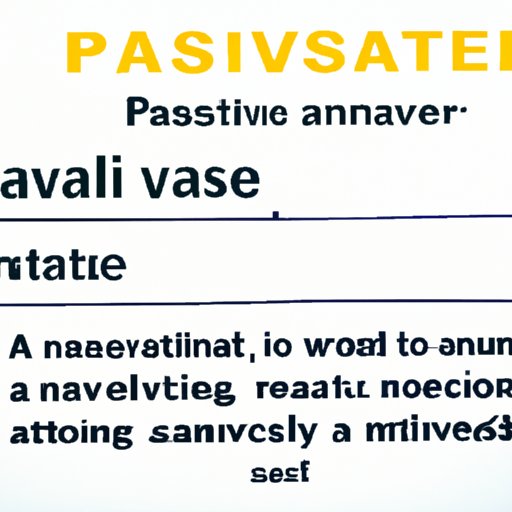Introduction
Passive writing is a type of writing style in which the subject of the sentence receives the action of the verb. It is one of two main types of writing styles – the other being active writing – and it can be used to great effect when used appropriately. In this article, we will explore what passive writing is, provide examples of passive writing, discuss the benefits and challenges of using passive writing, and offer strategies for improving passive writing.
Defining Passive Writing
Passive writing is defined as a type of writing in which the subject of the sentence receives the action of the verb. For example, in the sentence “The ball was kicked by John,” the subject (the ball) is receiving the action of the verb (kicked). This is an example of passive writing because the subject is not performing the action of the verb. Instead, the subject is being acted upon by another agent (John).
In contrast, active writing is a type of writing in which the subject of the sentence performs the action of the verb. For example, in the sentence “John kicked the ball,” the subject (John) is performing the action of the verb (kicked). This is an example of active writing because the subject is performing the action of the verb.
Examples of Passive Writing
Passive writing is commonly found in academic texts, such as research papers and journal articles. It is also often used in business documents, such as memos and reports. Additionally, passive writing can be found in legal documents and technical manuals.
To better understand passive writing, let’s look at some examples. In the sentence “The report was written by John,” the subject (the report) is receiving the action of the verb (written). This is an example of passive writing because the subject is not performing the action of the verb. In the sentence “John wrote the report,” the subject (John) is performing the action of the verb (wrote). This is an example of active writing because the subject is performing the action of the verb.
Benefits of Passive Writing
Passive writing has several benefits. First, it can make a text easier to read by removing the need for personal pronouns. For example, in a scientific paper, the writer may want to avoid using pronouns such as “I” or “we” to maintain a more formal tone. Second, passive writing can help to emphasize the object of the sentence instead of the subject. This can be useful in cases where the writer wants to focus on the object rather than the subject.
Finally, passive writing can be used to de-emphasize the subject of the sentence. This can be useful in cases where the writer does not want to draw attention to the subject. For example, in a legal document, the writer may want to minimize the role of the subject in order to focus on the facts of the case.
Challenges of Passive Writing
Although passive writing can be beneficial, there are some potential drawbacks. The first is that passive writing can make a text harder to read, as it removes the need for personal pronouns. This can make the text less engaging and more difficult to follow. Additionally, passive writing can make a text sound impersonal and distant. This can be off-putting to readers, who may find the text unappealing.
Another challenge with passive writing is that it can make a text seem overly complex. This can be problematic in situations where the writer needs to convey information clearly and concisely. Finally, passive writing can make a text seem too passive, which can lead to ambiguity and confusion.
Strategies for Improving Passive Writing
To improve passive writing, writers should strive to use active verbs whenever possible. Active verbs make a text easier to read and understand, as they provide clarity and concision. Writers should also avoid using nominalizations, which are words formed from verbs that are used to describe a noun. Nominalizations can make a text sound overly complicated and difficult to understand.
Other strategies for improving passive writing include using shorter sentences, avoiding long phrases, and using simple language. Additionally, writers should strive to use personal pronouns such as “I” and “we” whenever appropriate. This can help to add clarity and make the text more engaging.
Conclusion
In conclusion, passive writing is a type of writing in which the subject of the sentence receives the action of the verb. Examples of passive writing include academic texts, business documents, legal documents, and technical manuals. There are several benefits to using passive writing, including making a text easier to read, emphasizing the object of the sentence, and de-emphasizing the subject of the sentence. However, there are also some potential challenges to using passive writing, such as making a text harder to read and sound overly complex. To improve passive writing, writers should use active verbs, avoid nominalizations, and use personal pronouns whenever appropriate.
With practice, any writer can learn to use passive writing effectively. By understanding the benefits and challenges of passive writing, and by utilizing the strategies outlined in this article, writers can improve their passive writing skills and create clear and concise texts.
(Note: Is this article not meeting your expectations? Do you have knowledge or insights to share? Unlock new opportunities and expand your reach by joining our authors team. Click Registration to join us and share your expertise with our readers.)
